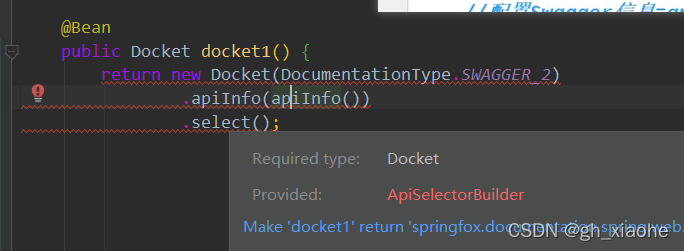目录
测试:http://localhost:8080/swagger-ui.html
?问题: 希望Swagger 在生产环境中使用,在发布的时候不使用?
swagger入门
导入依赖
<!-- https://mvnrepository.com/artifact/io.springfox/springfox-swagger2 -->
<dependency>
<groupId>io.springfox</groupId>
<artifactId>springfox-swagger2</artifactId>
<version>2.9.2</version>
</dependency>
<!-- https://mvnrepository.com/artifact/io.springfox/springfox-swagger-ui -->
<dependency>
<groupId>io.springfox</groupId>
<artifactId>springfox-swagger-ui</artifactId>
<version>2.9.2</version>
</dependency>配置swagger--->Config
@Configuration
@EnableSwagger2 //开启Swagger2的自动装配
public class SwaggerConfig {
}
测试:http://localhost:8080/swagger-ui.html

配置Swagger
Swagger的bean实例Docket
源码:
@Bean
public Docket docket1() {
return new Docket(DocumentationType.SWAGGER_2)
.apiInfo(apiInfo());
}
//配置Swagger2的apiInfo信息
private ApiInfo apiInfo() {
//作者信息
Contact contact = new Contact("gh", "https://blog.csdn.net/gh_xiaohe?spm=1000.2115.3001.5343", "2495140780@qq.com");
return new ApiInfo(
"Swagger2 API文档", //标题
"文档描述写啥我也不知道!!!", //描述
"V1.0", //版本信息
"localhost:8080/hello", //组织链接
contact, //联系人信息
"Apache 2.0", //许可
"http://www.apache.org/licenses/LICENSE-2.0", //许可连接
new ArrayList() //扩展
);
}
?代码:

@Bean
public Docket docket1() {
return new Docket(DocumentationType.SWAGGER_2)
.apiInfo(apiInfo());
}
@Bean
public Docket docket1() {
return new Docket(DocumentationType.SWAGGER_2)
.apiInfo(apiInfo());
}
//配置Swagger2的apiInfo信息
private ApiInfo apiInfo() {
//作者信息
Contact contact = new Contact(
"gh",
"https://blog.csdn.net/gh_xiaohe",
"2495140780@qq.com");
return new ApiInfo(
"Swagger2 API文档", //标题
"文档描述写啥我也不知道!!!", //描述
"V1.0", //版本信息
"https://www.bilibili.com/", //组织链接
contact, //联系人信息
"Apache 2.0", //许可
"http://www.apache.org/licenses/LICENSE-2.0", //许可连接
new ArrayList() //扩展
);
}
配置扫描接口
? ? ? ? 接口过滤
Docket.select()

@Bean
public Docket docket1() {
return new Docket(DocumentationType.SWAGGER_2)
.apiInfo(apiInfo())
.select()
.build();
} @Bean
public Docket docket() {
return new Docket(DocumentationType.SWAGGER_2)
.apiInfo(apiInfo())
.select()
/*
只有两个选项 .apis() .paths
拉姆达表达式 是个接口 使用实现类
RequestHandlerSelectors 配置要扫描接口的方式
basePackage:根据包扫描接口
any():扫描所有 项目中所有的接口都会被扫描
none():都不扫描
withClassAnnotation():根据类上的注解进行扫描
withMethodAnnotation():根据方法上的注解进行扫描
*/
.apis(RequestHandlerSelectors.basePackage("com.gh.controller"))
.build();
}
@Bean
public Docket docket() {
return new Docket(DocumentationType.SWAGGER_2)
.apiInfo(apiInfo())
.select()
/*
只有两个选项 .apis() .paths
拉姆达表达式 是个接口 使用实现类
RequestHandlerSelectors 配置要扫描接口的方式
basePackage:根据包扫描接口
any():扫描所有 项目中所有的接口都会被扫描
none():都不扫描
withClassAnnotation():根据类上的注解进行扫描 传入 注解的反射对象
withMethodAnnotation():根据方法上的注解进行扫描 withClassAnnotation(GetMapping.class))
*/
.apis(RequestHandlerSelectors.basePackage("com.gh.controller"))
//过滤 过滤什么路径
.paths(PathSelectors.ant("/gh/**")) //扫描这个包,并且 只扫描带有 gh 这个请求的接口
.build();
}
?配置是都启动Swagger
//enable 是否启动 Swagger 如果为false 则 Swagger 不能在浏览器访问 .enable(false) //默认true
@Bean
public Docket docket() {
return new Docket(DocumentationType.SWAGGER_2)
.apiInfo(apiInfo())
//enable 是否启动 Swagger 如果为false 则 Swagger 不能在浏览器访问
.enable(false) //默认true
.select()
/*
只有两个选项 .apis() .paths
拉姆达表达式 是个接口 使用实现类
RequestHandlerSelectors 配置要扫描接口的方式
basePackage:根据包扫描接口
any():扫描所有 项目中所有的接口都会被扫描
none():都不扫描
withClassAnnotation():根据类上的注解进行扫描 传入 注解的反射对象
withMethodAnnotation():根据方法上的注解进行扫描 withClassAnnotation(GetMapping.class))
*/
.apis(RequestHandlerSelectors.basePackage("com.gh.controller"))
//过滤 过滤什么路径
// .paths(PathSelectors.ant("/gh/**")) //扫描这个包,并且 只扫描带有 gh 这个请求的接口
.build();
}

?
?问题: 希望Swagger 在生产环境中使用,在发布的时候不使用?
- 判断是不是生产环境? flag = false
- 注入enable (flag)
application.properties
????????spring.profiles.active=dev
application-dev.properties
?? ? ??server.port=8081
application-pro.properties
????????server.port=8082
@Bean
public Docket docket(Environment environment) {
//设置要显示的Swagger环境
Profiles profiles = Profiles.of("dev","test");
//获取项目的环境
//通过environment.acceptsProfiles 来判断是否处在自己设定的环境当中
boolean flag = environment.acceptsProfiles(profiles);
return new Docket(DocumentationType.SWAGGER_2)
.apiInfo(apiInfo())
//enable 是否启动 Swagger 如果为false 则 Swagger 不能在浏览器访问
.enable(flag) //默认true
.select()
/*
只有两个选项 .apis() .paths
拉姆达表达式 是个接口 使用实现类
RequestHandlerSelectors 配置要扫描接口的方式
basePackage:根据包扫描接口
any():扫描所有 项目中所有的接口都会被扫描
none():都不扫描
withClassAnnotation():根据类上的注解进行扫描 传入 注解的反射对象
withMethodAnnotation():根据方法上的注解进行扫描 withClassAnnotation(GetMapping.class))
*/
.apis(RequestHandlerSelectors.basePackage("com.gh.controller"))
//过滤 过滤什么路径
// .paths(PathSelectors.ant("/gh/**")) //扫描这个包,并且 只扫描带有 gh 这个请求的接口
.build();
}?
?配置Api文档分组
.groupName("Hello-Swagger")?
?

?问题:如何配置多个组? ? 多个Docket实例即可
/**
* 配置多个分组 只需往往容器里多注入几个Docket的bean
*/
@Bean
public Docket docket1(){
return new Docket(DocumentationType.SWAGGER_2).groupName("AAA");
}
@Bean
public Docket docket2(){
return new Docket(DocumentationType.SWAGGER_2).groupName("BBB");
}
@Bean
public Docket docket3(){
return new Docket(DocumentationType.SWAGGER_2).groupName("CCC");
}?
实体类配置?
@ApiModel
@ApiModelProperty
@Api(注释)
@ApiOperation("Hello控制类")? ? //Operation 接口? 不是放在类上,是方法
@ApiParam 方法形参?
user
//给生成的文档加一个注释
@Api(注释)
@ApiModel("User:用户实体类")
public class User {
@ApiModelProperty("用户名")
public String username;
@ApiModelProperty("密码")
public String password;
}
HelloController? ?
????????????????只和 返回值?中? 有无实体类有关 和有无注解无关
@RestController
public class HelloController {
@GetMapping("/hello")
public String hello(){
return "Hello,Swagger";
}
//只要我们的接口中,返回值中存在实体类,他就会被扫描到 Swagger 中
@GetMapping("/user")
public User user1(){
return new User();
}
}

?
//Operation 接口 不是放在类上,是方法
@ApiOperation("Hello控制类")
@PostMapping("/hello2")
public String hello2(@ApiParam("用户名") String name){
return name;
}
?
?目录:
SwaggerConfig
package com.gh.config;
import org.springframework.context.annotation.Bean;
import org.springframework.context.annotation.Configuration;
import org.springframework.core.env.Environment;
import org.springframework.core.env.Profiles;
import org.springframework.web.bind.annotation.GetMapping;
import springfox.documentation.builders.PathSelectors;
import springfox.documentation.builders.RequestHandlerSelectors;
import springfox.documentation.service.ApiInfo;
import springfox.documentation.service.Contact;
import springfox.documentation.service.VendorExtension;
import springfox.documentation.spi.DocumentationType;
import springfox.documentation.spring.web.plugins.Docket;
import springfox.documentation.swagger2.annotations.EnableSwagger2;
import java.util.ArrayList;
@Configuration
@EnableSwagger2 //开启Swagger2的自动装配
public class SwaggerConfig {
@Bean
public Docket docket(Environment environment) {
//设置要显示的Swagger环境
Profiles profiles = Profiles.of("dev","test");
//获取项目的环境
//通过environment.acceptsProfiles 来判断是否处在自己设定的环境当中
boolean flag = environment.acceptsProfiles(profiles);
return new Docket(DocumentationType.SWAGGER_2)
.apiInfo(apiInfo())
.groupName("Hello-Swagger")
//enable 是否启动 Swagger 如果为false 则 Swagger 不能在浏览器访问
.enable(flag) //默认true
.select()
/*
只有两个选项 .apis() .paths
拉姆达表达式 是个接口 使用实现类
RequestHandlerSelectors 配置要扫描接口的方式
basePackage:根据包扫描接口
any():扫描所有 项目中所有的接口都会被扫描
none():都不扫描
withClassAnnotation():根据类上的注解进行扫描 传入 注解的反射对象
withMethodAnnotation():根据方法上的注解进行扫描 withClassAnnotation(GetMapping.class))
*/
.apis(RequestHandlerSelectors.basePackage("com.gh.controller"))
//过滤 过滤什么路径
// .paths(PathSelectors.ant("/gh/**")) //扫描这个包,并且 只扫描带有 gh 这个请求的接口
.build();
}
//配置Swagger2的apiInfo信息
private ApiInfo apiInfo() {
//作者信息
Contact contact = new Contact(
"gh",
"https://blog.csdn.net/gh_xiaohe",
"2495140780@qq.com");
return new ApiInfo(
"Swagger2 API文档", //标题
"文档描述写啥我也不知道!!!", //描述
"V1.0", //版本信息
"https://www.bilibili.com/", //组织链接
contact, //联系人信息
"Apache 2.0", //许可
"http://www.apache.org/licenses/LICENSE-2.0", //许可连接
new ArrayList() //扩展
);
}
// private ApiInfo apiInfo() {
// return new ApiInfo(
// "Api Documentation",
// "Api Documentation",
// "1.0",
// "urn:tos",
// DEFAULT_CONTACT,
// "Apache 2.0",
// "http://www.apache.org/licenses/LICENSE-2.0",
// new ArrayList());
// }
/**
* 配置多个分组 只需往往容器里多注入几个Docket的bean
*/
@Bean
public Docket docket1(){
return new Docket(DocumentationType.SWAGGER_2).groupName("AAA");
}
@Bean
public Docket docket2(){
return new Docket(DocumentationType.SWAGGER_2).groupName("BBB");
}
@Bean
public Docket docket3(){
return new Docket(DocumentationType.SWAGGER_2).groupName("CCC");
}
}
HelloController
package com.gh.controller;
import com.gh.pojo.User;
import io.swagger.annotations.ApiOperation;
import io.swagger.annotations.ApiParam;
import org.springframework.web.bind.annotation.GetMapping;
import org.springframework.web.bind.annotation.PostMapping;
import org.springframework.web.bind.annotation.RestController;
@RestController
public class HelloController {
@GetMapping("/hello")
public String hello(){
return "Hello,Swagger";
}
//只要我们的接口中,返回值中存在实体类,他就会被扫描到 Swagger 中
@GetMapping("/user")
public User user(){
return new User();
}
//Operation 接口 不是放在类上,是方法
@ApiOperation("Hello控制类")
@GetMapping("/hello2")
public String hello2(@ApiParam("用户名") String name){
return name;
}
@ApiOperation("post")
@PostMapping("/post")
public User post(@ApiParam("用户名") User user){
return user;
}
}
User
//给生成的文档加一个注释
//@Api(注释)
@ApiModel("User:用户实体类")
public class User {
@ApiModelProperty("用户名")
public String username;
@ApiModelProperty("密码")
public String password;
}
总结:
- 我们可以通过Swagger给一些比较难理解的属性或者接口,增加注释信息
- 接口文档实时更新
- 可以在线测试
【注意点】在正式发布的时候,关闭Swagger!!!出于安全考虑。而且节省运行的内存;